Project Activities | Itinerary | Price | Trip Reviews | Prior Trip Reports
Restoring the Scottish Highlands!
For the past 9,000 years humans inhabited and altered the Scottish highland landscape. Early hunters and gatherers left stone tools and evidence of campsites as they followed deer herds, while farming dates back to 4000 BC. Forests were cleared, non-native plants introduced, and livestock grazing altered vegetation and prevented native trees, shrubs and wildflowers from growing, resulting in significant loss of biodiversity.
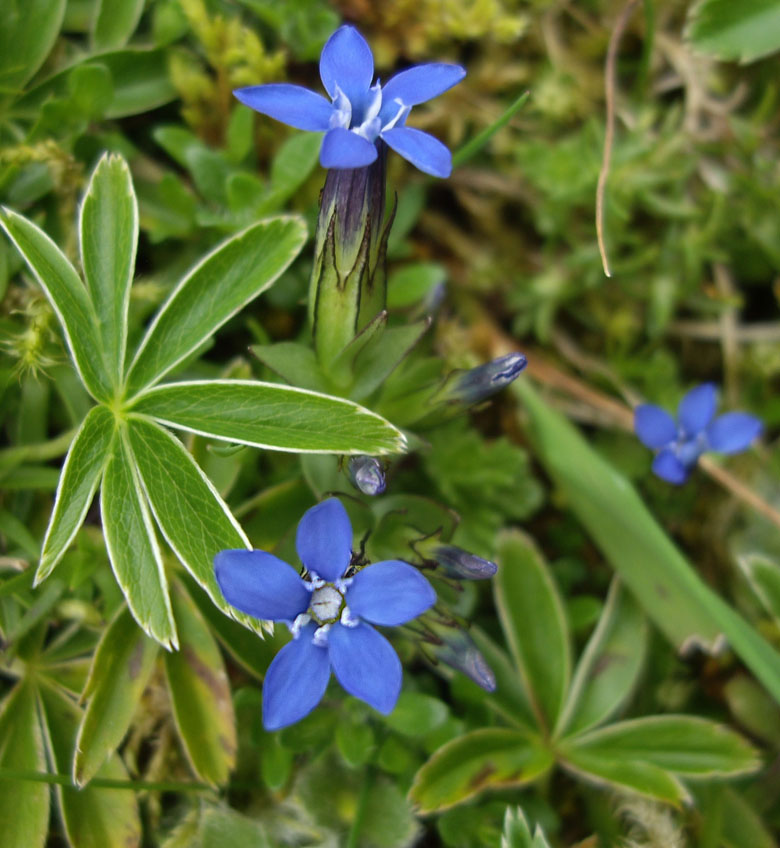
Join ConservationVIP’s volunteer trip to help restore Loch Lomond and the Trossachs, Scotland’s first National Park, and the Ben Lawers National Nature Reserve, home to Great Britain’s rarest alpine plants and ecosystems.
This is a unique opportunity to volunteer under the guidance of rangers from the National Trust for Scotland (NTS) alongside the people whose life’s work is dedicated to protecting some of the most significant Scottish natural ecosystems and historic sites!
Trip participants help with important conservation projects in two locations under the guidance of specialists from the National Trust for Scotland.
Our first location will be in Loch (lake) Lomond and the Trossachs National Park, the stomping grounds of legendary Rob Roy MacGregor made famous and fictional by Sir Walter Scott.

The Park is a diverse region of lochs, glaciated valleys, forested slopes and sparsely vegetated ridges, featuring Ben Lomond, one of Scotland’s higher Munros (mountains over 3,000 feet). Beautiful Loch Lomond, the largest loch in Great Britain, is dotted with small islands.
Next, we will travel north to the charming village of Killin, at the base of Ben Lawers National Nature Reserve, renowned for its very rare remnants of alpine plant communities.
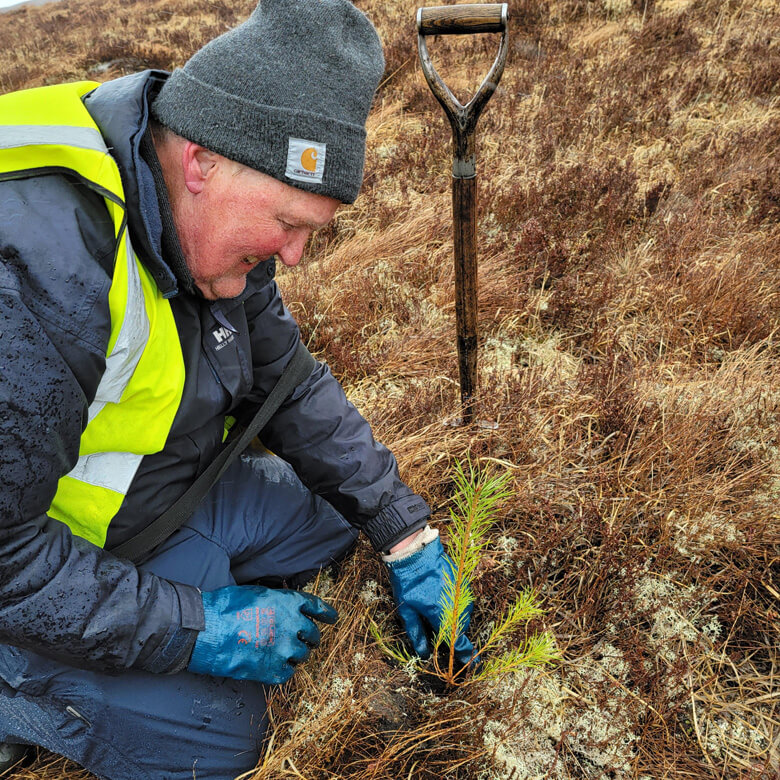
Projects may include planting native trees, removing invasive plants, maintaining footpaths to prevent erosion and protect surrounding vegetation, and building or removing wood post and wire fencing designed to exclude sheep and deer from areas undergoing restoration.
No prior experience is required. We will train you in all aspects of volunteering. Past volunteers have included a variety of ages, experience and abilities. You should be able to hike 1-3 miles a day on both on and off trail including some steeper stretches or uneven terrain, moving dirt and rocks with a shovel, and pulling unwanted plants. While the Scottish mountains are rugged and scenic they rarely top 3,000 feet, and high elevation is generally not an issue.
As always, safety is our priority.
Please look through the tabs on the left for more details about the itinerary, price, and gear list
Day 1: Meet in Glasgow, Scotland.
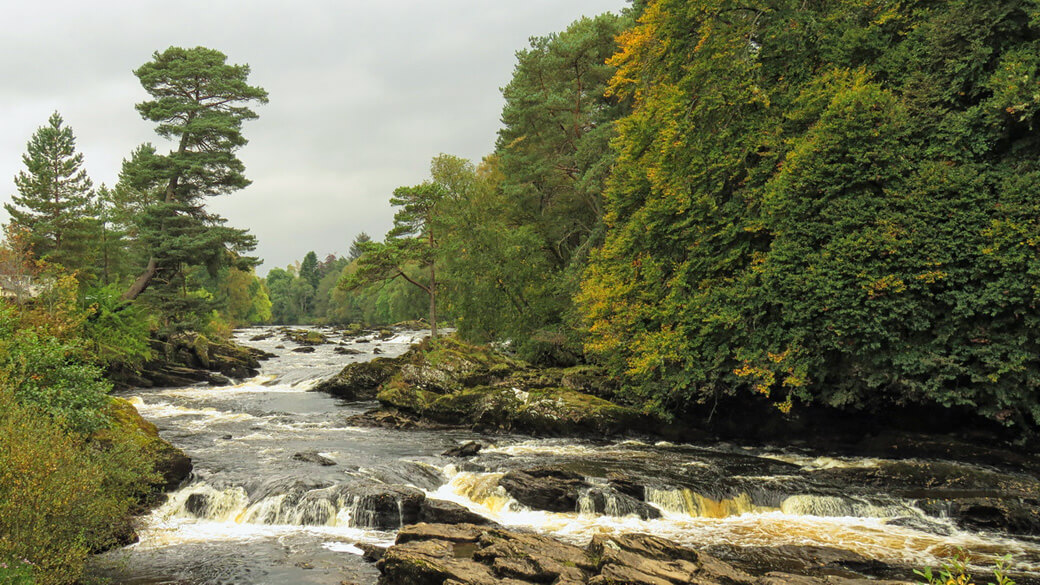
Welcome to Scotland! Our trip begins at 5:00 p.m. with an orientation where you’ll get acquainted with your trip leaders and fellow volunteers and get an overview of our exciting days ahead. Our group meets in a hotel in downtown Glasgow, Scotland’s largest city and once home to a booming shipbuilding industry. After our orientation, we’ll walk together to a local restaurant specializing in Scottish cuisine. (Dinner and lodging included)
Day 2: Travel to Rowardennan in Loch Lomond and the Trossachs National Park, with a few significant stops in between
After breakfast in the hotel, we’ll be picked up by our driver and enjoy a guided tour of some scenic vistas, significant historic sites, and engineering marvels on our way to Loch Lomond and the Trossachs National Park. We’ll visit the mythical shape-shifting Kelpies, meet and greet some sociable hairy coos (iconic Scottish highland cattle), see the Falkirk Wheel- a ferris wheel to lift boats between upper and lower canals, and Stirling Castle, one of the more significant sites in Scottish history.
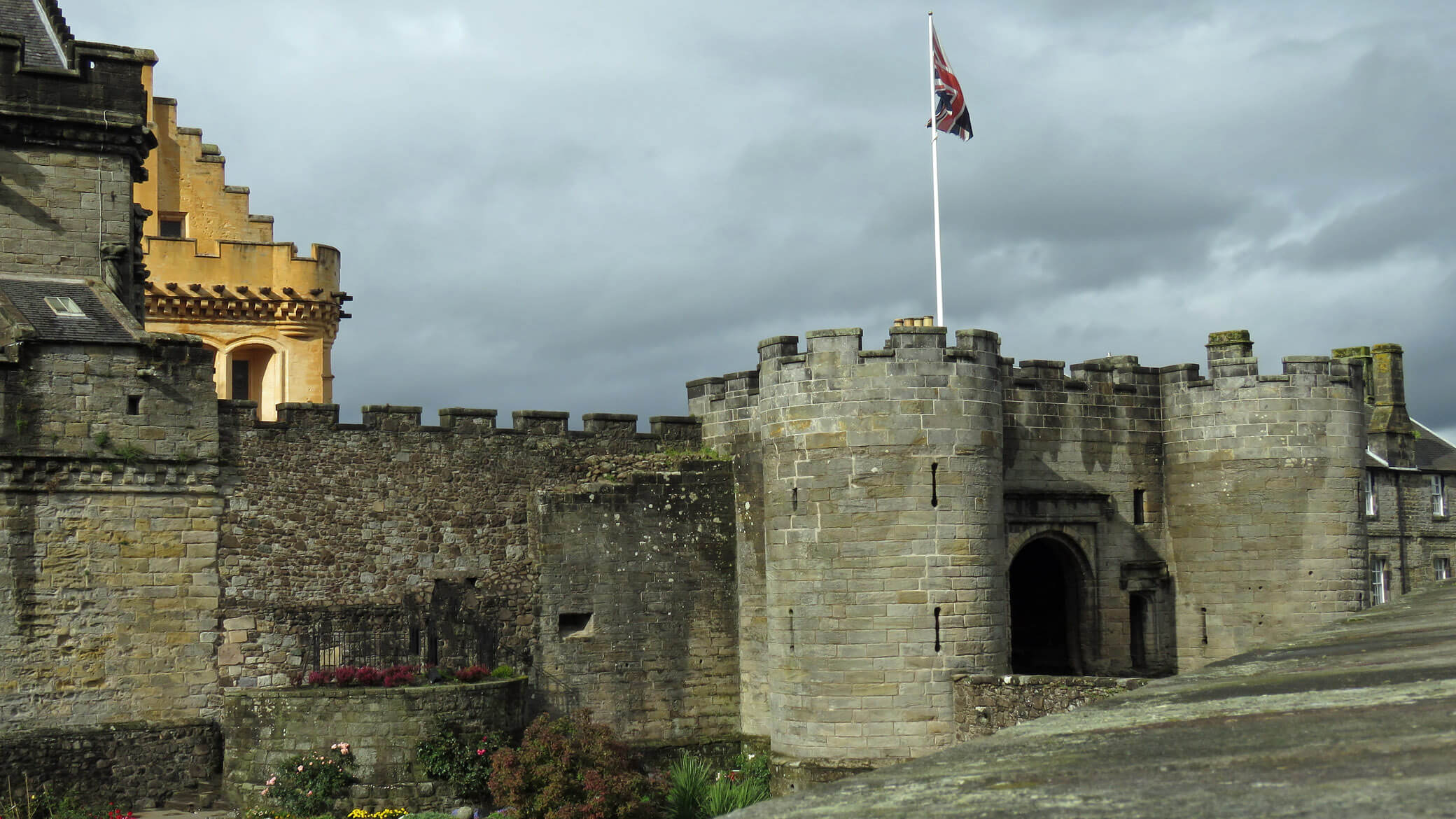
In the afternoon we will check into the NTS Ardess Lodge on the shores of Loch Lomond, our lodging for the next 4 nights.
A hearty vegetarian dinner will be prepared by your private chefs – the trip leaders – who gladly welcome sous and guest chef volunteers! Following dinner, the National Trust rangers will discuss our projects for the next few days. (All meals and lodging provided. Note that all meals at the park will be vegetarian).
Days 3 – 6: Conservation projects in the Loch Lomond and the Trossachs National Park
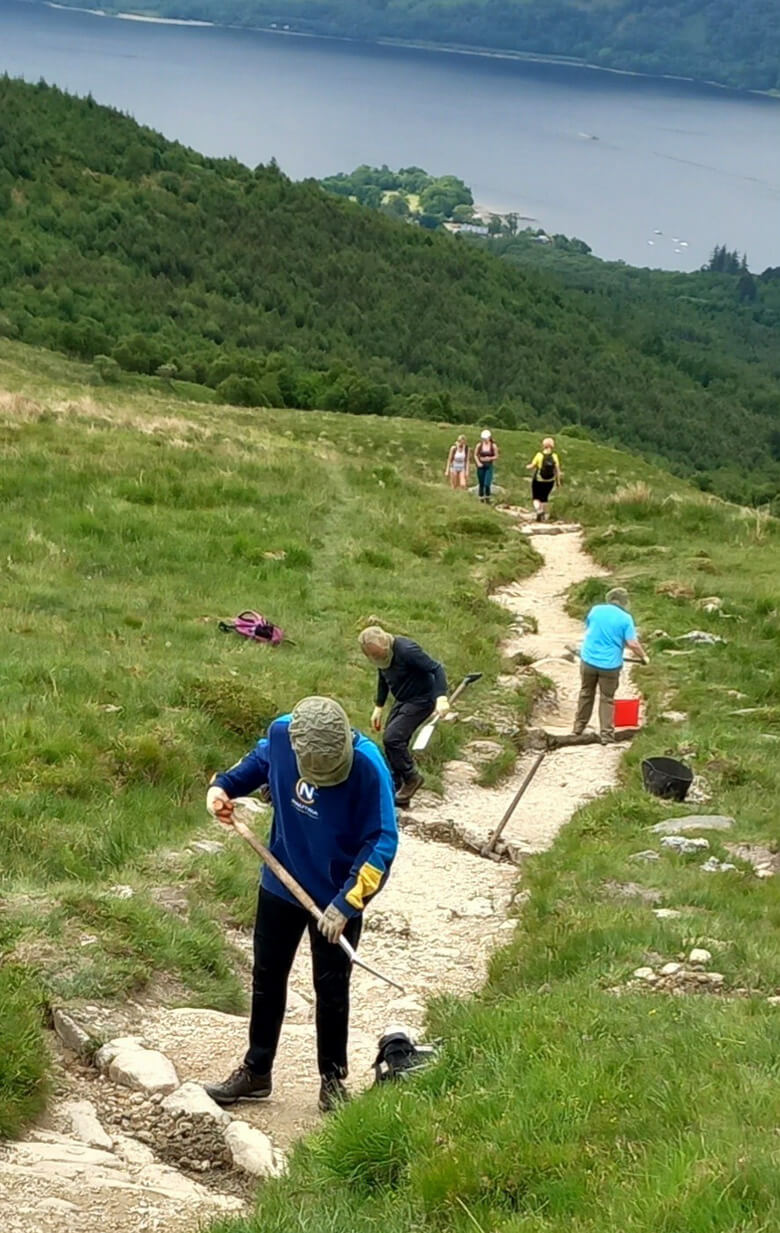
A typical volunteer project day consists of preparing a hearty breakfast of your choice, packing your lunch, and being geared up and ready to go at 8:30 a.m. As we participate in volunteer projects throughout the day the NTS rangers will provide us with guidance and information about the critically important nature of our projects, and about the history, ecology and local lore of the area. After our projects end for the day, generally around 4:30 p.m., you’ll have time to relax before dinner.
After dinner there is time to relax, read, or tell stories. (All meals and lodging included.)
Day 7: Rest and travel to Ben Lawers National Nature Reserve

Today we will travel to Killin and the Ben Lawers National Nature Reserve, where we will spend the remainder of our volunteer time. Our lodging for the second half of our trip will be the National Trust offices on the main street in Killin. The Victorian era building contains the National Trust offices for the Reserve, employee and volunteer lodging, and a small native plant nursery. We’ll be housed in 2 bunkhouse style rooms. (All meals and lodging included)
Days 8-11: Conservation projects in the Ben Lawers Natural Nature Reserve.

The daily schedule is similar to the project days at our first location. After our projects you’ll have a chance to explore the charming village of Killin.
Killin is a historic conservation village within the Loch Lomond and Trossachs National Park. Some features to check out are the Falls of Dochart, the Kinnell stone circle and the Moirlanich Longhouse. (All meals and lodging included)
Day 12: Return to Glasgow where trip ends
After breakfast, we will pack up and return to Glasgow, where our trip ends. From there, you can catch a plane home or continue your adventures via bus, ferry, or rail.
IMPORTANT NOTES about the Itinerary:
- Day 1 is the day you should plan to arrive at the meeting point for the trip. This may require departing your hometown one or more days in advance and traveling on an overnight flight.
- Before purchasing your airline tickets, please check with us to ensure the trip has the necessary minimum number of participants required to operate.
- Although we do our very best to adhere to the itinerary above, it is subject to change for reasons beyond our control, including changes in the local project needs, weather, and terrain conditions.
US$2,495 for twelve days (Note: Your trip expense may be tax-deductible. Please see our Frequently Asked Questions page and consult your tax adviser for details.)
Price includes:
- all meals from dinner on Day 1 through breakfast on the final day
- hotel in Glasgow; rooms are double occupancy
- bunkhouses at the national park
- all bus and van transportation noted
- gratuities for services provided to the group
- project leadership and support staff
- group tools
- orientation and training
Price does not include:
- airfare to/from Scotland
- cost of medical immunizations
- insurance (emergency medical and evacuation insurance is mandatory for this trip)
- excess baggage charges
- airport taxes
- alcoholic beverages or soft drinks
- personal items
Deposit and Cancellation
A deposit of $500 per person is required at the time of signup; final payment is due at 90 days prior to departure. The payment and refund policy can be found here.
Group Size: 6 – 8 plus trip leaders
Submit your review | |
It's a ConservationVIP trip I have wanted to take for a number of years and finally did. I was not disappointed. I was most interested in learning about and participating in the reforestation efforts in the Scottish Highlands. But it was much more than that. Woven in was the history and culture of Scotland. I left having a much better understanding of this wonderful country, and also a desire to return. The accommodations, the food, the trip leaders and the Trees for Life folks were all top notch.
Never having visited Scotland before, and not really sure of the adventures ahead of us, I was primed for any events that CVIP and Trees for Life had planned for us volunteers. We experienced a smorgasbord of beautiful mountains, lochs, crazy weather, fabulous Dundreggran staff, rewilding training, and best of all, time with each other. Like other CVIP trips I've participated in, I'm left with great memories and a real desire to return soon.
Everything about the experience was remarkable: ConservationVIP planning and guidance from Barbara and Richard, the seamless integration with Trees for Life program, the range of activities, tours and of course, the weather. That our group was so compatible and productive was partially due to luck but also to your thoughtful planning. Thank you and keep me on the list for next Scotland adventure.
It was a great trip in a beautiful spot. We did good work for good cause. Local leaders were very knowledgeable and helpful. The volunteers were a nice mix of people who all pitched with all the projects and meal prep.
I have participated in several Conservation VIP projects and this one did not disappoint! The facilities were great, the food even better. But it was the beautiful country that stole the show. It was so moving planting trees that will live for years and reseed for even more years to come. Liv and Sally, with Trees for Life, were knowledgeable, funny, patient and great guides for the week we were together. I highly recommend this trip!
Amazing. Super well-run, excellent and timely pre-trip information, great group and camaraderie. And the local staff shepherding us around daily were beyond fun, wonderful, energetic and interesting. We learned so much about the Highlands, land maintenance, competing interests and of course, about trees. An unforgettable experience. Well done, CVIP!
The program for Trees For Life is an important and fun way to get people involved with a hands on way of making the planet healthier. The leaders were generous with their time before and during the trip. The Highlands of Scotland are awesome. Go see for yourself.
Exceeded expectations! Fantastic mission, trip leaders and rewarding work. Richard, Kenda & Debra are 100% committed to making it a great experience and work very hard to make sure everything goes as smoothly as possible.
The key to staying comfortable while on an active trip is layering. To get maximum comfort with minimum weight, you need versatile layers that mix and match to create the right amount of insulation, ventilation and weather protection. The gear list has been created to help you in choosing your equipment for the trip. View the Gear List PDF.
Click to view the PDF Trip Reports.
April 2024
May 2023
June 2022
September 2019
April-May 2019
September 2018
September 2017
September 2016
September 2015
Also, read our guest blog to see how a volunteer described her experience.
Please check with your doctor to see if any immunizations are recommended for you.
ConservationVIP has always focused on our volunteers’ safety. Traveling with safety concerns requires some extra planning and flexibility both for trip leaders and trip participants!
To prevent illness or injury on the trip, participants may have to follow procedures such as mask-wearing, social distancing, methods for carrying and using tools and other site-specific procedures as instructed by the trip leader. More specific safety instructions will be provided on the trip.
Participants will also have to comply with any restrictions imposed by Scotland and your country of origin at the time of travel. While we know that the restrictions may change between now and the time of travel, we cannot predict what those changes will be.
Read more about why we think our Scottish Highlands trip is ideal for people looking for Sustainable Travel.
Scotland is a fabulous place to visit
If you have more time, we encourage you to extend your stay and explore the landscapes, oceans and history and culture of beautiful Scotland.
Glasgow has its own charm, with the University District, home to the University of Glasgow, one of the centers of enlightenment in the 18th century. It is also home to a variety of art, science and history museums. Glasgow is centrally located with airport, train, ferry and bus connections to where you want to go.
We heartily recommend visiting Edinburgh, Scotland’s capital and a UNESCO World Heritage Site to see its medieval old town and 18th century New Town. Edinburgh is full of energy and highly walkable and is a one-hour trip from Glasgow.
